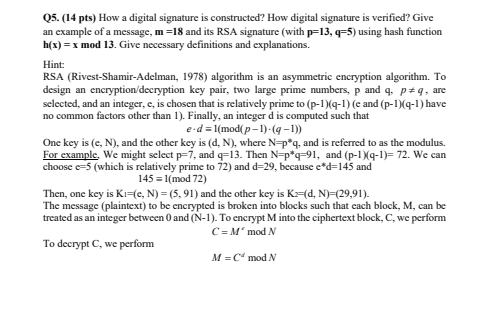
Q5. (14 pts) How a digital signature is constructed? How digital signature is verified? Give an example of a message, m=18 and its RSA signature (with p=13, 4F5) using hash function h(x) = x mod 13. Give necessary definitions and explanations. Hint: RSA (Rivest-Shamir-Adelman, 1978) algorithm is an asymmetric encryption algorithm. To design an encryption/decryption key pair, two large prime numbers, p and 4, p=9, are selected, and an integer, e, is chosen that is relatively prime to (p-1)(-1) (e and (p-1)(q-1) have no common factors other than 1). Finally, an integer d is computed such that e-d=l(mod(p-1)-(4-1)) One key is (c, N), and the other key is (d, N), where N=p*4, and is referred to as the modulus. For example. We might select p=7, and 13. Then N=p*q=91, and (p-1Xq-1)= 72. We can choose 5 (which is relatively prime to 72) and d=29, because e*d=145 and 145 = 1(mod 72) Then, one key is K1=, N)(5,91) and the other key is K=(d, N)=(29,91). The message (plaintext) to be encrypted is broken into blocks such that each block, M, can be treated as an integer between 0 and (N-1). To encrypt M into the ciphertext block, C, we perform C=M' mod N To decrypt C, we perform M=C mod N Q5. (14 pts) How a digital signature is constructed? How digital signature is verified? Give an example of a message, m=18 and its RSA signature (with p=13, 4F5) using hash function h(x) = x mod 13. Give necessary definitions and explanations. Hint: RSA (Rivest-Shamir-Adelman, 1978) algorithm is an asymmetric encryption algorithm. To design an encryption/decryption key pair, two large prime numbers, p and 4, p=9, are selected, and an integer, e, is chosen that is relatively prime to (p-1)(-1) (e and (p-1)(q-1) have no common factors other than 1). Finally, an integer d is computed such that e-d=l(mod(p-1)-(4-1)) One key is (c, N), and the other key is (d, N), where N=p*4, and is referred to as the modulus. For example. We might select p=7, and 13. Then N=p*q=91, and (p-1Xq-1)= 72. We can choose 5 (which is relatively prime to 72) and d=29, because e*d=145 and 145 = 1(mod 72) Then, one key is K1=, N)(5,91) and the other key is K=(d, N)=(29,91). The message (plaintext) to be encrypted is broken into blocks such that each block, M, can be treated as an integer between 0 and (N-1). To encrypt M into the ciphertext block, C, we perform C=M' mod N To decrypt C, we perform M=C mod N







